How to help your students dig deeper into character change with mentor texts
Mentor texts are a great way to help students understand complex reading comprehension skills. Picture books are often used to teach mini-lessons that deepen student understanding. While this is a great starting place, many upper elementary students are ready to dig into more complex examples. Teaching character change, for example, can be taken to a deeper level through novels because they give the reader an in-depth look at the characters and the events that impact them.
Today I wanted to share some of my favorite mentor texts for teaching students how to analyze character change across time. I’ll also explain how you can use the classic novel Charlotte’s Web by E.B. White to help your students transition to a deeper level of thinking about how and why characters change. I’ll even share some great printables you can use to help you facilitate these lessons in your classroom.
Disclosure: I’ve included Amazon Affiliate links where applicable. These products won’t cost you any extra, but the earnings from the use of these links help support the maintenance of this site.
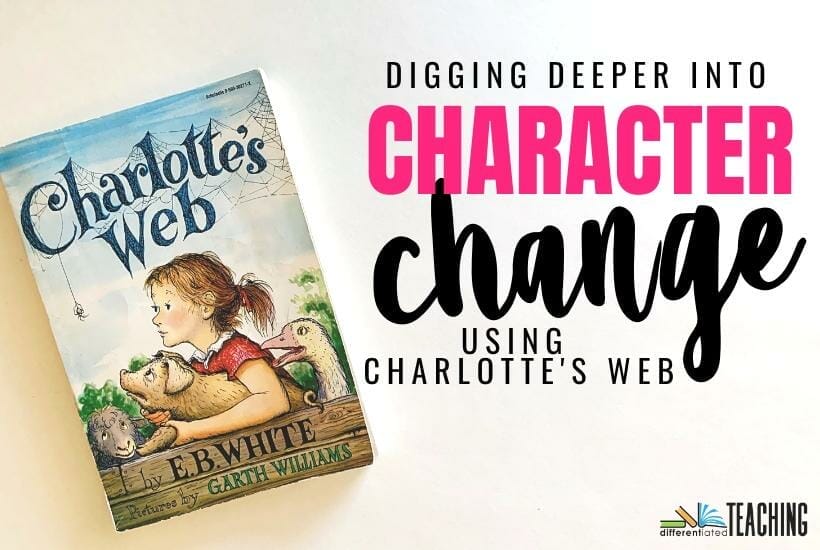
Getting started teaching character development
Whether you’re a new teacher or you’re just looking to change up how you’ve taught these skills in the past, it can be difficult to figure out just where to start your instruction on character development.
To help you get started here is some background information on prerequisite skills and standards.
What standards address character change?
This skill is introduced in very different grade levels depending on what standards you use. In Texas, the TEKS have this standard included in third grade. However, the Common Core standards do not introduce character change until 6th grade.
Here are the specific standards to aid with lesson plan documentation:
- TEKS 3.8B Describe the interaction of characters including their relationships and the changes they undergo.
- CCSS RL.6.3 Describe how a particular story’s or drama’s plot unfolds in a series of episodes as well as how the characters respond or change as the plot moves toward a resolution.
What reading comprehension skills do my students need to have before I start?
Before introducing a lesson on analyzing character change, it is important to make sure your students have a strong understanding of character traits.
Students must be able to identify character traits and provide text-based evidence to support their decisions before they can analyze how the events of a story have changed the character.
In addition, students need to be able to identify main events because these are typically the catalysts for character change. When students are proficient in these two skills, it will be easier to work through the process of analyzing how characters change over time.
What picture books are good for introducing character change?
Picture books are a great way to introduce students to the concept of character change because they take less time to read so you can easily finish the text in a single lesson.
While picture books often don’t offer the same depth of analysis as longer texts would, they are a good starting point and can be beneficial for early lessons to build background.
Here are some of my favorite picture books for introducing this skill:
- A Bad Case of Stripes by David Shannon
- Sheila the Brave by Kevin Henkes
- Enemy Pie by Derek Munson
- Boundless Grace by Mary Hoffman
Analyzing character change at a deeper level
Once students have a strong understanding of the process of analyzing character change, it can be beneficial to allow them to dig deeper into the process using a novel as a mentor text.
You can easily start the novel as a read-aloud or in small group literature circles when you’re beginning to teach your mini-lessons on character traits and transitioning to analyzing character change. This will give you time to get into the meat of the text prior to students being ready to dig deeper.
Here’s an example of how you can use Charlotte’s Web to help students begin analyzing how and why characters change across time at a deeper level. Just enter your email to grab these freebies to help your students organize and document their understanding.
Grab the Character Trait List and Lesson Freebies!
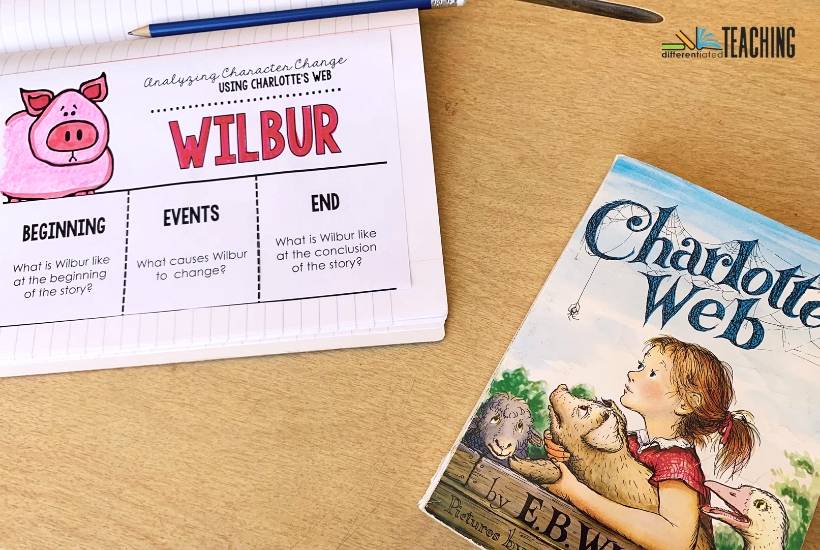
Before Reading: Introducing the skill
As you begin your discussion of character development, it can be helpful to have students reflect on their background knowledge.
One easy way to do this is to have students write about a time they changed their mind about something. Just like characters in a story, there are events in our lives that change how we view things.
This graphic organizer is a great way to get students thinking about the reasons people may change before they even start reading. You might consider doing this before you teach some lessons on character development using the picture books mentioned above.
Otherwise, it can be a great introductory task as you begin reading Charlotte’s Web.
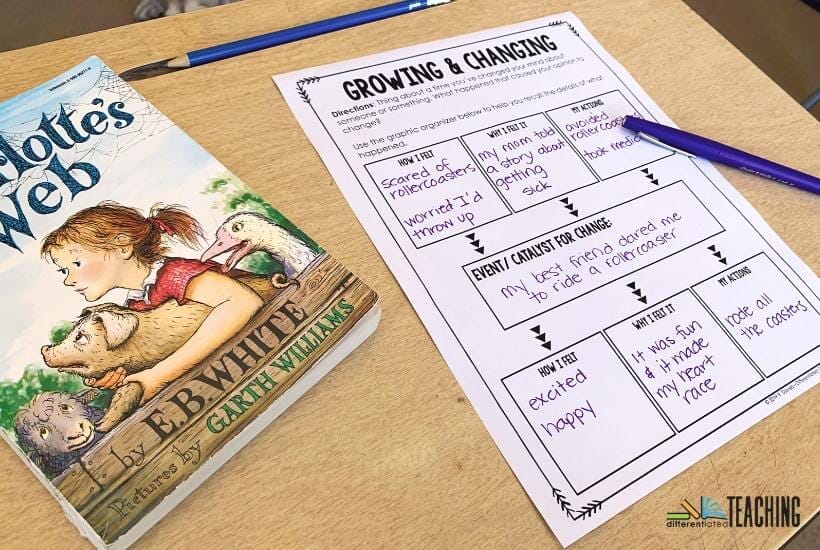
Charlotte’s Web Summary
In case you haven’t read the story. Charlotte’s Web is the story of a girl and the runty pig she saves from being slaughtered. She names the pig Wilbur and raises him as if he is a baby until he gets too big.
Wilbur is sent to live at a nearby farm that belongs to the girl’s uncle. It is there he meets a spider named Charlotte, who ultimately saves his life.
During Reading: Identify the character traits
As you read the first part of Charlotte’s Web, have students pay particular attention to the main character’s traits, feelings, and actions.
I recommend keeping a character traits anchor chart to help you keep track of the main characters. It doesn’t need to be anything fancy. Just a simple table that allows you to track the traits and changes characters undergo through the story. Here’s an easy example:
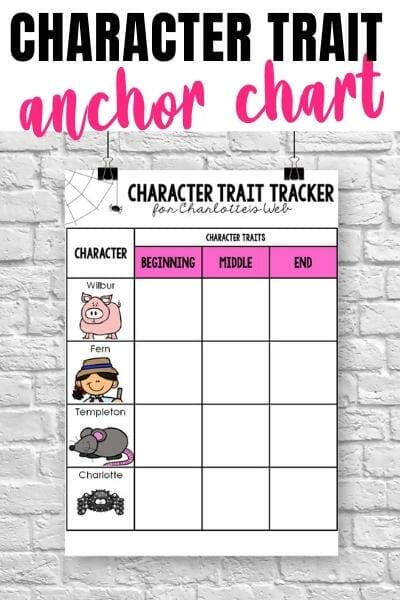
You can even use a graphic organizer to track these throughout the story. This will make it much easier to point out and discuss the changes that occur as a result of the plot.
After Reading: Analyzing & documenting character change
After you finish the book, have students reflect on how both Wilbur and Fern changed during the course of the story.
You can use the free flipbooks I’ve shared in this post to help your students document how and why both characters changed.

This can also be a great way to start the discussion about the different reasons characters change.
Some of the changes that occur in Charlotte’s Web are developmental, like Fern’s newfound interest in boys. Others are the result of specific events, like Wilbur’s discussion with the goose.
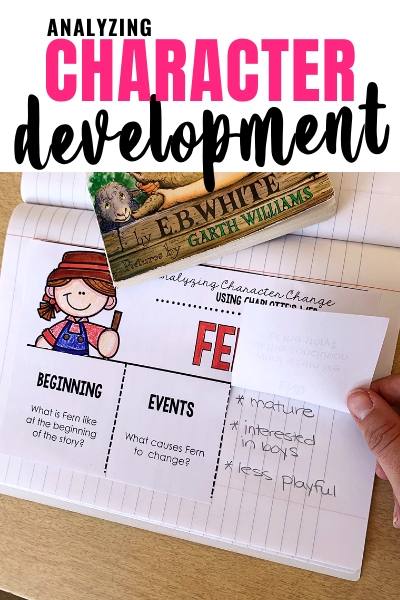
You can even make connections between the characters and the students’ writing from the beginning of the novel through to the end.
Grab these free resources for teaching character change
Now that you’ve seen how to help students transition from a basic understanding of character change to a deeper level of analysis, I’m sure you’re itching to try it out in your classroom.
That’s why I created a set of free resources for teaching this skill. In this free pack, you’ll find:
- Growing & changing brainstorming organizer
- Character change graphic organizer
- Original reading passage with character development comprehension questions
- Wilbur & Fern character change flipbooks
- Post-reading reflection – Analyzing character change in Templeton
Even better I’ve also decided to do a giveaway of all the books mentioned in this article. To grab the free resource, enter your name & email below.






